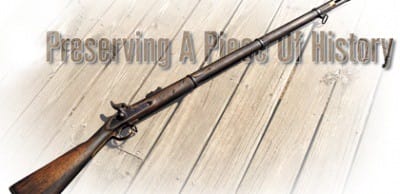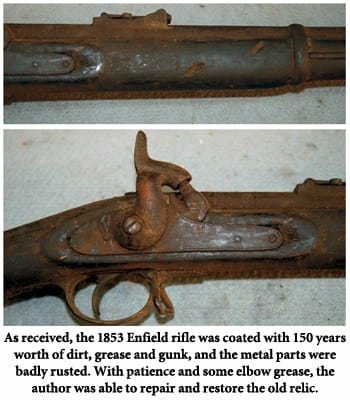By Reid Coffield, ShootingTimes

Like a lot of folks, I grew up with an interest in military arms and history. As a teenager during the centennial commemoration of the Civil War in the 1960s, I was “bitten by the bug” and desperately wanted a rifle used during that historic conflict. I wanted a rifle of the type that was perhaps carried by members of my family. Unfortunately, even with what would now be considered incredibly cheap prices, I just couldn’t afford one. My part-time job as a grocery store bag boy never produced enough money to spend on a Springfield 1861 or Model 1853 Enfield. I was lucky to be able to afford an old Mauser or Mosin-Nagant. Rifles like that could be bought for less than $20, which was about the limit of my less than substantial income.
I still admire and appreciate antique guns from that era, but I have gradually come to accept that it just isn’t in the cards for me to own one. That being said, a part of me still wanted a gun to hang on the wall. The 19th-century guns are attractive, and they always stir my imagination. Whenever I hold one in my hands, I can’t help but wonder where it’s been, who carried it and how it was used.
Some time ago, I noticed an ad from International Military Antiques in Shotgun News. These folks were advertising “untouched” Model 1853 Enfield-type rifles for just $250. The rifles were part of a huge collection of firearms purchased by Christian Cranmer from the government of Nepal in September 2000. This is perhaps the last large group of antique arms that will ever be offered for sale in the U.S. By the way, by large, I mean huge. According to Cranmer, over 430 tons of guns and accessories were brought out of Nepal!

At that price, this rifle is definitely affordable. In fact, if I look at the price in terms of the 1962 dollars of myteenage years, it would sell for considerably less than $50! Also, it was from the right period. While this rifle never saw use in the American Civil War, thousands of its cousins did. The Model 1853 Enfield was the most commonly used rifle in the Civil War, and both Union and Confederate governments imported tens of thousands of these rifles. While most were made in England, many were produced in Germany, Belgium and Spain.
You might think it’s odd that a British-type rifle was made in the Himalayan Mountains. It seems that back around 1813 the British, who controlled India, fought a brief war with the Nepalese. The Nepalese came darn close to winning, but in the end the British prevailed and took control of the area. The Brits let the Nepalese run their own internal affairs, but they kept close tabs on the Nepalese military. One aspect of that was controlling the types of arms the Nepalese were allowed to have. The Brits tried to make darn sure the Nepalese, who were excellent fighters, never had arms that were as technologically advanced as their own. Consequently, the Nepalese were generally kept one generation behind the Brits. For example, when the British were using metallic-cartridge rifles, the Nepalese were still using percussion firearms.
This article was contributed by ShootingTimes, a publication of Intermedia Outdoors. Visithttp://rifleshootermag.com/ for more useful shooting articles.







